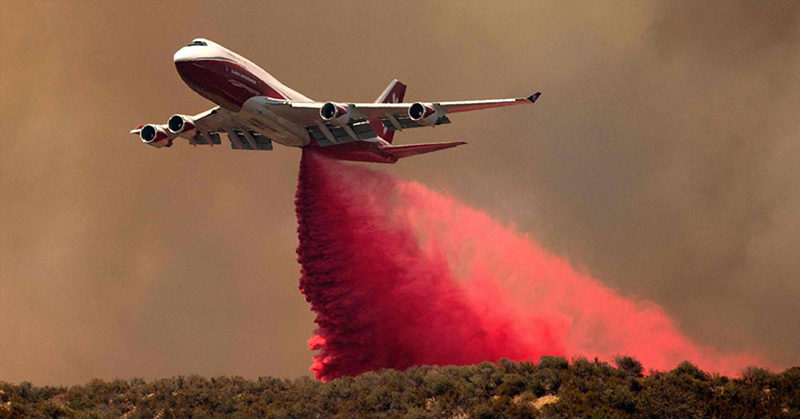Forest and wildfires are becoming more dangerous every year. In 2020 alone, we’ve seen these fires devastate parts of Australia, Ukraine, Serbia, Brazil, and California. The blazes can tear across forests and homes and reduce them to smoldering ash. Putting them out is no easy task.
Firefighters can battle the flames from the ground but air support is often necessary. Aerial tankers can dose the fires with water or fire retardant, a dangerous mission, but a truly heroic one. This is the perfect task for retired airliners who are no longer flying freight or passengers.
The Boeing 747: The Plane Transformed into a Fire-Fighting Machine
Not many planes are built for firefighting, so older aircraft are being reconstructed into flying ‘fire trucks’. The bigger the jet, the more helpful they will be to stop the fires.
Introducing the Boeing 747. It was once the largest passenger airliner in the world (until the A380 came to be) and now it’s the largest firefighter airliner. It’s the only one of its kind and it has saved lives all over the globe. The gigantic frame stores water tanks to extinguish fires wherever they are. The seats were removed to make room for the tanks, which can hold 19,200 gallons of water. [1]
Before it began fighting fires, the Boeing 747 flew for Japan Airlines and Evergreen International Airlines.
Like a bombardier on a warplane, the person sitting by the command station deploys the water through the ports on the bottom of the aircraft. There’s also the “emergency dump” button that releases all of the contents in the tanks. In flight, the plane looks like something out of an action movie, diving over the flames and releasing a red fire retardant beneath them. Aside from its vital missions, the plane looks fairly average on the outside.
The Boeing 747 is Fighting the 2020 Californian Wildfires
The Boeing 747 is also appropriately dubbed the Global Supertanker. Nowadays, it fights the blazing wildfires in California where there have been over 560 blazes all over the state. The weather has increased the risk of spreading the fires and mulitply them with its dry thunderstorms and pyrocumulus clouds.
Piloting the Boeing 747 and similar aircrafts is a hazardous job. The planes must get close to the flames to put it out, which is truly not for the faint of heart. The Boeing 747 is the only aircraft of the Global Supertanker Services, which is based in Colorado. However, it can still operate from any airport that has an 8,000-foot runway among other necessary facilities.
The plane was the first one certified by the Federal Aviation Administration (FAA) in September 2016. Since then, it has fought wildfires in Israel and Chile, as well as California back in 2017. It can spray water or a fire retardant over an area about 3 miles long and is about 150 feet wide. [2]
The Three Main Types of Aircraft in the Californian Air Force
The California wildfires has blackened about 2.2 million acres according to the California Department of Forestry and Fire Protection (Cal Fire). Cal Fire has its own aircraft fleet to fight the recurring wildfires, including tactical planes, airtankers and helicopters. As of August 23, about 95 of these aircrafts were fighting the fires.
The tactical aircrafts monitor the fires and direct the other crafts to the most endangered areas. The helicopters deploy water and transports firefighters and any equipment required. Finally, the tankers exclusively drop water or fire retardants. The Boeing 747 falls under this latter category. It’s remarkable how many crafts were recycled from typical airliners into these fire-fighting machines.
Meanwhile, 15,600 firefighters battle from the ground against the 19 largest fires in California since September 1. [3]
Two of the Worst Californian Wildfires Ever
Some of the firefighters are working 24-hour shifts due to the numerous fires and lack of resources. This shortage is partially because the Covid-19 pandemic has released prison inmates early.
These inmate firefighters “are an integral part of our firefighting operations,” according to Christine McMorrow, a Cal Fire spokeswoman. Meaning, 600 less inmates are available for these wildfires compared to the amount last year.
These fires include the LNU Lightning Complex Fire and SCU Lightning Complex Fire, which are “the second and third largest that have occurred in California,” said Incident Commander Sean Kavanaugh. “…To have both of those going off at the same time is saying something. It gives us the magnitude of what has happened here in the last week here in the state.” [4]
Since the lightning strike that ignited the fires that began on August 15, over 900 new wildfires started up. Horrifyingly, almost 1.5 million acres has been burned since then. As devastating as the wildfires are, at least there is a committed air force doing their utmost to stop them. All the respect goes to the firefighting pilots and crew who fly into the heart of the danger to extinguish as much as they can.
Keep Reading: Washington becomes seventh U.S. state to outlaw wildlife killing contests
References:
[1] “Retired passenger airliners are getting a second life fighting fires as iconic jets are repurposed as water bombers – take a look.” Thomas Pallini. Business Insider. August 23, 2020
[2] “Former Passenger Planes Repurposed to Fight Wildfires.” Mark B. The Science Times. August 23, 2020
[3] “Air attack.” Marco Hernandez, Simon Scarr and Manas Sharma. Reuters Graphics. September 9, 2020
[4] “Deadly California wildfires scorch more than 1 million acres with no end in sight.” Amir Vera and Jamiel Lynch. CNN. August 24, 2020

